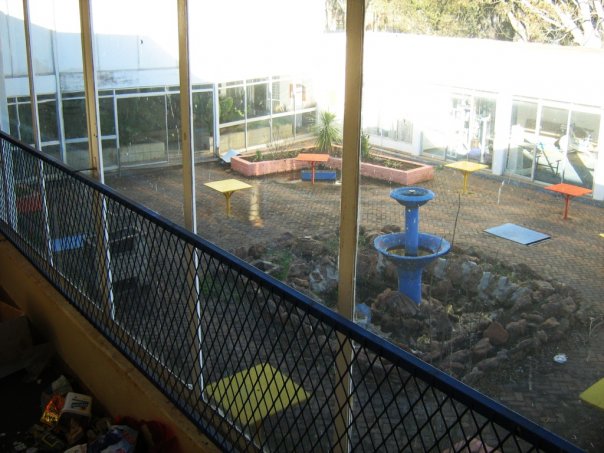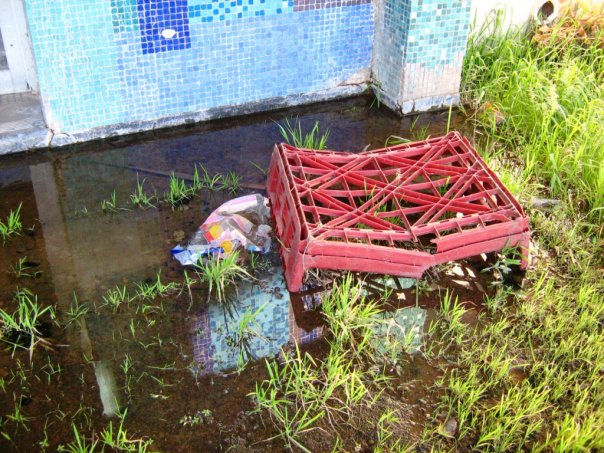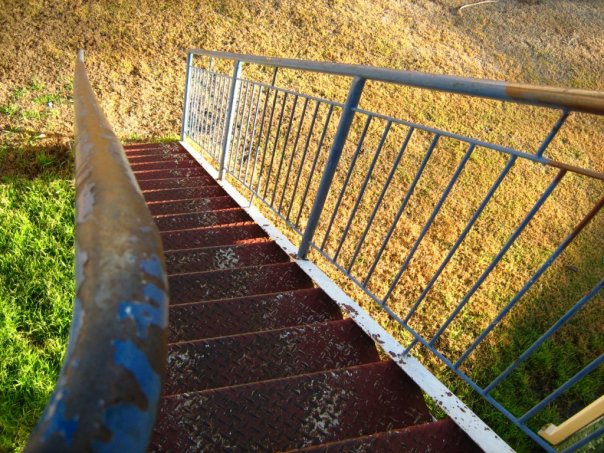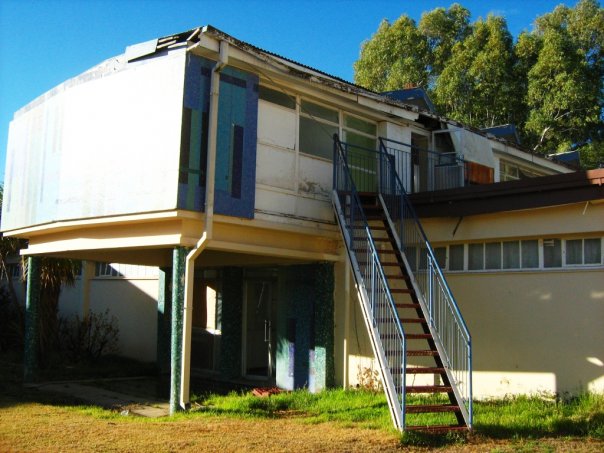The photographs in this post are of an abandoned hot springs resort/health spa, taken by me in July 2009. The resort is situated in Aliwal North, a tiny town on the border of South Africa’s Free State and Eastern Cape provinces. During Victorian times, and continuing into the dark era of Apartheid, this settlement on the Orange River was a popular holiday destination (whose amenities would have been available to whites only). I was stuck here for several days following a car accident, so I went exploring. I was told by a local that the resort had fallen into disrepair only recently, in the past decade, due to mismanagement of the allocated maintenance funds. I wondered to what extent this might reflect a rejection of the resort’s oppressive past by its post-1994 custodians.
I share the fascination with documenting ruins and decay that is the subject of the following excerpt from the excellent blog, Archaeology and Material Culture:
An astounding number of web pages document abandoned materiality, encompassing a broad range of architectural spaces including asylums, bowling alleys,industrial sites, Cold War sites, and roadside motels as well as smaller things like pianosand even scale models of abandonment. This ruination lust is not simply the province of a small handful of visual artists, hipsters colonizing Detroit, or recalcitrant trespassers; instead, it invokes something that reaches far deeper socially, has international dimensions, extends well into the past, and reflects a deep-seated fascination with—if not apprehension of—abandonment. The question is what explains our apparently sudden collective fascination with abandonment, ruination, and decay. The answers are exceptionally complex and highly individual, but there seem to be some recurrent metaphors in these discourses.
For “urban explorers” (a term that might loosely include artists, photographers, archaeologists, and curious folks alike), such journeys seek out “abandoned, unseen, and off-limits” spaces that imagine ruination in a wide range of artistic, emotional, scholarly, and political forms. Many of these urban explorers and artists see themselves as visual historians, documenting the architectural and community heritage reflected in abandoned spaces. For instance, Jonathan Haeber’s urban exploration blog Bearings explains that “I’m just an eye. I’m just a camera. … An urban explorer is just a documentarian. … We only appreciate the creations that are overlooked. … It is what remains that is the democratic equivalent of a revolution.”
This is a politically circumspect expression of the explorer as a visual chronicler who records the prosaic material dimensions of abandoned material heritage. It focuses on the power of aesthetically documenting abandonment, often to fortify a general appreciation for the breadth of heritage but not always in especially articulate ways. Urban Ghosts: Forgotten Places and Urban Curiosities, for example, argues that its mission through such images is to underscore that “History is all around us, on every street corner. Almost every place has a story to tell, but so much goes unnoticed, or simply pales into insignificance alongside heavy-hitting giants like the pyramids.” …
 … Many of these projects focus on how the photographic representation of abandonment is utterly dependent on the bodily experience of a creative, curious, and sympathetic eye moving through ruined landscapes. Matthew Christopher’s Abandoned America page has thoroughly chronicled urban abandonment, and his assessment of abandonment hinges on the physical experience of moving through these ruined landscapes, which he refers to as the “visceral experience of entering a parallel universe.” In an Atlantic Cities article on“ruin porn,” Christopher acknowledged that “It was a case of that old cliché, ‘a picture speaks a thousand words.’ … When I’d try to talk about the presences that seem to linger in these places, people would look at me like I should be in an asylum myself. When I showed them pictures — they’d suddenly get it.
… Many of these projects focus on how the photographic representation of abandonment is utterly dependent on the bodily experience of a creative, curious, and sympathetic eye moving through ruined landscapes. Matthew Christopher’s Abandoned America page has thoroughly chronicled urban abandonment, and his assessment of abandonment hinges on the physical experience of moving through these ruined landscapes, which he refers to as the “visceral experience of entering a parallel universe.” In an Atlantic Cities article on“ruin porn,” Christopher acknowledged that “It was a case of that old cliché, ‘a picture speaks a thousand words.’ … When I’d try to talk about the presences that seem to linger in these places, people would look at me like I should be in an asylum myself. When I showed them pictures — they’d suddenly get it.
”Many if not most urban explorers believe that a visual record of a place is uniquely documented by a photographer who thinks creatively and embraces prosaic ruination, taking pictures in ways that our sight may not otherwise have seen and stressing what Travis Parno calls “the potency of the imagination.” Beauty in Decay, for instance, aspires to “walk in the eerie footsteps of long departed souls through haunted houses turned to dust and industrial complexes surrendered to nature,” arguing that “to understand the siren song of these places requires a certainly more poetic mindset than one might be used to occupying. Think back to your childhood for a moment and it all begins to make sense. … At the very point we cross the border from childhood into adolescence we cross real physical borders too. It’s the moment in our lives when we test the boundaries.”
Read more of this fascinating article by Brian Dillon at Archaeology and Material Culture.












‘(…) Walter Benjamin famously declared ‘allegories are in the realm of thoughts what ruins are in the realm of things’.’
[http://fs.oxfordjournals.org/content/61/2/155.full]
‘Walter Benjamin saw in ruins ‘allegories of thinking itself,’ a meditation on ambivalence.’
[http://cabinetmagazine.org/issues/28/boym2.php]
‘The ghost of Benjamin is searching other ruins for a glimpse of the redemption of humankind.’
[http://www.markhutchinson.org/writing/writing%20the%20ruin%20of%20benjamin.html]
<3 Wow…Thank you, P-brain. I can't wait to look at these references in more detail sometime soon… I love Walter Benjamin's writing on history… So poetic.
I’m in Dublin at the moment and my artist friend Seoidin O’Sullivan, whose work focuses on abandoned and disused inner-city spaces (check out the latest project she is involved in here: http://themanhattanrising.wordpress.com/) showed me a collection of essays, “Ruins”, edited by Brian Dillon and published by Whitechapel Gallery: http://www.whitechapelgallery.org/shop/product/category_id/31/product_id/982
Here’s the blurb (more for my own reference than anything else!):
The “ruins” of the modern era are the landmarks of recent art’s turn toward site and situation, history and memory. The abiding interest of artists in ruination and decay has led in particular to the concept of the modern ruin – an ambiguous site of artistic and architectural modernism, personal and collective memories, and the cultural afterlife of eras such as those of state communism and colonialism. Contemporary art’s explorations of the ruin can evoke on the one hand diverse experiences of nostalgia and on the other a ceaselessly renewed encounter with catastrophes of the recent past and apprehensions of the future. For every relic of a harmonious era or utopian dream stands another recalling industrial decline, environmental disaster, and the depredations of war.
This anthology provides a comprehensive survey of the contemporary ruin in cultural discourse, aesthetics, and artistic practice. It examines the development of ruin aesthetics from the early modern era to the present; the ruin as a privileged emblem of modernity’s decline; the relic as a portal onto the political history of the recent past; the destruction and decline of cities and landscapes, with the emergence of “non-places” and “drosscape”; the symbolism of the entropic and decayed in critical environmentalism; and the confusing temporalities of the ruin in recent art–its involution of timescales and perspectives as it addresses not just the past but the future.
Artists surveyed include Edgar Arceneaux, Miroslaw Balka, Bernd & Hilla Becher, Walead Beshty, Martin Boyce, Gerard Byrne, Adam Chodzko, Jeremy Deller, Katja Eydel, Ângela Ferreira, Cyprien Gaillard, Dominique Gonzalez-Foerster, Susan Hiller, Roger Hiorns, Runa Islam, Ilya Kabakov, Joachim Koester, Robert Kusmirowski, Zoe Leonard, Vera Lutter, Goshka Macuga, Teresa Margolles, Dorit Margreiter, Edgar Martins, Julie Mehretu, Christian-Philipp Müller, Mike Nelson, Paulina Olowska, The Otolith Group, Philippe Parreno, Mai-Thu Perret, Walid Raad – The Atlas Group, Conrad Shawcross, Robert Smithson, Rachel Whiteread and Jane & Louise Wilson.
Writers include Magali Arriola, J.G. Ballard, Jean Baudrillard, Svetlana Boym, Giuliana Bruno, J.J. Charlesworth, Barbara Clausen, Jonathan Crary, Jacques Derrida, Jörg Heiser, Martin Herbert, Andreas Huyssen, Patrick Keiller, Darian Leader, Mark Lewis, James Lingwood, Tom McDonough, Jeremy Millar, Celeste Olalquiaga, Nina Power, Ralph Rugoff, Lytle Shaw, Iain Sinclair, Robert Smithson, Rebecca Solnit, Susan Stewart, Anthony Vidler, Paul Virilio and Gilda Williams.